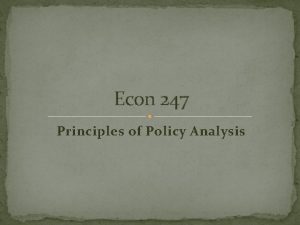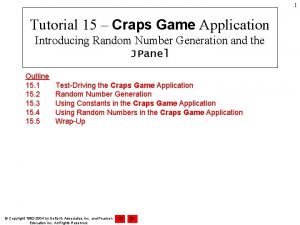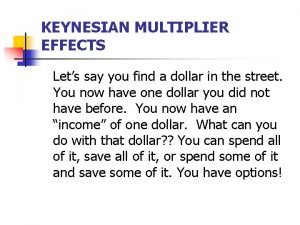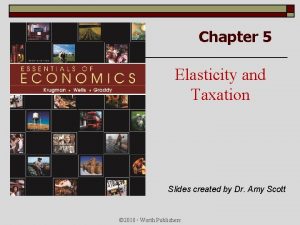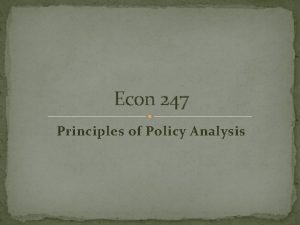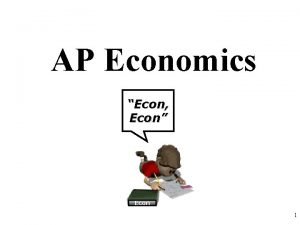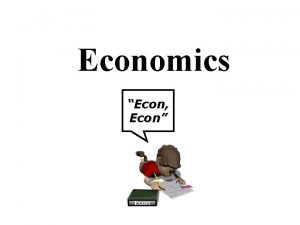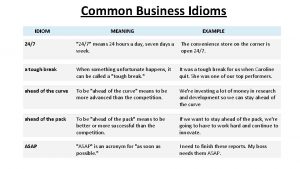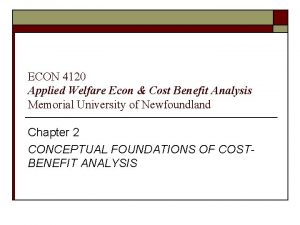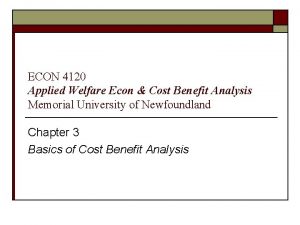Econ 247 Principles of Policy Analysis Overview Markets























- Slides: 23

Econ 247 Principles of Policy Analysis

Overview �Markets are a good way to organize economic activities �However, the government often plays a role in today’s modern economies 2

Examples �Governments often interfere in economic activities: � Regulating prices of goods � Restricting trade in certain commodities � Imposing taxes � Banning trade or certain activities � Setting standards 3

Rationales for public policy Market failures: occur when the market fails to achieve the desired outcome (fails to maximize social welfare). When does the market fail? � Externalities � Imperfect competition � Public Goods � Imperfect information �Government intervention can potentially correct market failures 4

Other Rationales for public policy Besides intervention to correct market failures, the government may intervene in markets for �Distributional concerns �Ethical reasons �Political pressures 5

Rationales for public policy �However, public policies can have unintended consequences � Individuals react to the policy in a way that weakens its effect � Other decision makers can be affected � Tradeoffs involved between different policy objectives 6

Economic Systems, Resource Allocation, and Social Well-Being

The Economic Problem �Resources are used to produce goods and services to satisfy human needs and wants. �Resources are limited. �Needs and wants are unlimited. Society has to make a decision

What, How and for Whom? �Society has to decide: What goods will be produced using the scarce resources.

What, How and For Whom? �Society has to decide: How to produce them

What, How and For Whom? �Society has to decide: Who gets the goods and services produced

Answer �Different possible answers �The answer will determine the type of economic system.

Answer �Solution 1: Individuals own resources They freely decide how to allocate their resources in a way that is meaningful to them. A Pure Market Economy

Answer �Solution 2 The government assumes ownership of all resources The government decides how to allocate them A Pure Command Economy

Answer �Solution 3: A system that combines elements of the pure market and the pure command system A Mixed Economy

Resource Allocation in a Command Economy �A state planning commission develops a plan that determines production quantities for each major product �Resources allocated accordingly to each sector �Ministries, bureaus, local and regional planning offices were involved

Resource Allocation in a Command Economy �Workers assigned to positions according to a planning committee. Often the government committed itself to creating a job to each individual �Households allocated a set amount of goods, a system often called a rationing system

Problems of Central Planning 18 Informational Requirements 1. § § Planners needed to collect information to determine the quantities to be produced of each good, the technology to use, which resources to allocate and how to distribute the finished goods. Often shortages and surpluses existed Problems with pricing Quality of products suffered

Problems of Central Planning 2. Incentives for Efficient Production units run by government officials instead of owners Workers were paid an amount independent of their true effort No incentives to put extra effort as the resulting gains will be shared by all workers

Resource Allocation in a Market Economy � Resource owners offer them to the best uses Workers decide how many hours to work. Similarly landowners and capital owners decide where to put their resources All decisions are coordinated in markets The market outcome determines the quantity of resources allocated for each use and the price

Resource Allocation in a Market Economy �Market Structure Purely Competitive Markets � Large number of buyers and sellers � Each seller offers standardized product � Product prices free to move up or down � Buyers and sellers must be mobile � Freedom of entry and exit Purely Monopolistic Markets � One seller Imperfectly Competitive Markets

Market Demand Supply Price $ Surplus 9 8 S D 7 6 5 4 Shortage S D 3 5 6 7 8 9 10 Quantity

Prices as Signals in a Market System �Prices act as signals Prices inform producers of how much to produce and therefore how much of the resources to be allocated to this use A change in preferences will result in a price change which guides resource allocation A higher price results with stronger preferences as the demand curve shifts right. More resources will be allocated to this use
 Econ 247
Econ 247 Marginal analysis econ
Marginal analysis econ Money247
Money247 Usf employee assistance program
Usf employee assistance program 562-247-8422
562-247-8422 562-247-8422
562-247-8422 247 templates
247 templates 40 cfr 247
40 cfr 247 Craps tutorial app
Craps tutorial app Cs 247
Cs 247 600 yuvarlanan sayılar
600 yuvarlanan sayılar Yoursafezone 247
Yoursafezone 247 Cs 247
Cs 247 Art 248 kpk
Art 248 kpk Chapter 1 overview of financial statement analysis
Chapter 1 overview of financial statement analysis Multiplier formula
Multiplier formula Econ crowding out
Econ crowding out Flip it econ
Flip it econ Econ 151
Econ 151 Midpoint method formula
Midpoint method formula Mps ap macro
Mps ap macro Econ austria
Econ austria Econ 1410
Econ 1410 Econ 424
Econ 424
